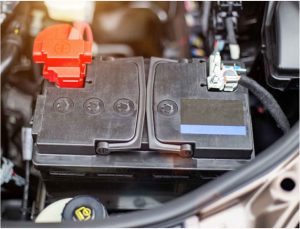All cars require a certain amount of power in order to start. That power is provided by the battery. The battery also provides enough power to run the lights and other accessories in the car while it is running.
Now car batteries lose their charge naturally even if your car is just sitting in your driveway. In order to keep your battery charged you have to charge it. A car battery charger is a handy device to have, as it will keep your car battery from dying and prolong its life.
A 100-watt solar panel can fully charge a car battery in around 12 hours. This is in full sunlight conditions so this can actually be two days as it won’t be charging at night.
You will need a solar panel with a charge controller to prevent the solar panel from overcharging the battery and prevent the solar panel from discharging the battery at night as the voltage will be lower than that of the battery.
A smaller 5-watt panel can provide a trickle charge to maintain the battery and prevent it from discharging and can be kept throughout.

How many amps to charge a car battery
So how many amps do you need to charge a car battery? The standard car battery is around 50 Ah and is rated at a 12v voltage. But the actual voltage of the battery when full is around 14v. So a discharge car battery will be around 11v and to charge it you need to get it 14v.
A standard car battery is rated at around 50 Ah. The maximum rate you can charge a lead-acid battery is 20% of its capacity or 0.2C. This means you can charge a car battery at 10 amps you can go lower even to 1 amp but you should never go higher than 10 amps as this may damage the battery.
How long will a car battery take to fully charge with a 100-Watt Solar Panel?
Depending on sunlight availability and how far the battery is discharged a 100-watt solar panel can fully charge a car battery in the course of a day.
A 50% discharged battery will take 2 to 3 hours to fully charge at 10 amps. A nearly depleted battery will take 6 to 8 hours. And this is for a standard car battery in a small-sized car. The bigger the battery and vehicle will be the longer it will take.
However, you will not need a 100-watt solar panel if you just need to maintain the battery. A small 10-watt solar panel and even a 5-watt solar panel is enough to maintain the battery if you leave it idle for a long period of time.
How long will a 10-watt Solar Panel take to charge a car battery?
A 10-watt solar panel can provide just shy of 1 amp of charge. If you charge a car battery at 1 amp at 50% the battery will take up to 48 hours to charge. To charge a nearly depleted battery it can take up to 96 hours. If you put this into sunlight hours it can take a full week to charge a car battery with a 10-watt solar panel.
Can I Leave a Solar Trickle Charger on all the time?
Yes, you can keep the battery charger on all the time if the solar trickle charger is 5 watts or less than that. If you using a bigger solar panel you need a charge controller. A charge controller will automatically sense when to charge or when to maintain and provide the appropriate charge.
If a battery’s state of charge is low, the charge controller will automatically apply a 15-volt high current boost to increase the available current to the battery from the solar panel. As the batteries near full charge, the charging voltage will step down to maintain the optimum level necessary for long life without overcharging or boiling.
Why does it take this long to charge a car battery?
A battery has to undergo various stages in order to become fully charged. An empty battery will charge quicker than a battery at half capacity. This is because the more the battery is charged the voltage increases and this provides more resistance to charge coming in. This applies to Lead-acid batteries (Gel and AGM) and it’s only lithium batteries that behave differently.
Stages of a Battery Charge Cycle
A battery cycle occurs when a battery is discharged and then recharged.
A battery charge cycle typically contains four stages: charging, absorption, float, and equalization. The charging stage is when power is first applied to the battery, and the current is highest.
The absorption stage is when the voltage starts to level off and the current decreases. The float stage is when the voltage remains constant and the current is very low.
The equalization stage is when the voltage is increased for a short period of time in order to equalize the charge in all the cells.
The voltage of the battery determines the stage of the battery and how fast it will charge and how many amps it can take in:
Bulk Stage
The bulk charging stage of a battery’s charge cycle is when the battery is charged at its maximum rate until it reaches approximately 80% of its full capacity. At this point, the charge rate is reduced to avoid overcharging the battery.
Absorption Stage
In the absorption stage, the voltage is increased to a level above the battery’s normal operating voltage. This creates a “plateau” of constant current flow, allowing the battery to be fully charged with minimal gassing.
Float Stage
The float stage of a battery’s charge cycle is the period of time when the battery is fully charged and is no longer being actively charged by the charger. During this time, the battery’s voltage will remain constant. At this point, a small charge should be applied to keep the battery topped off.